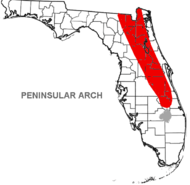Peninsular Arch
| Peninsular Arch Stratigraphic range: Jurassic | |
|---|---|
| Type | Geological structure |
| Unit of | Florida Platform |
| Sub-units | None |
| Lithology | |
| Primary | Carbonate |
| Location | |
| Region | North Florida to South Florida |
| Country |
|

The Peninsular Arch is a dominant sub-surface structure of the geology of Florida.
Age
The arch was present from the Jurassic ~199.6—145.5 Ma through the Paleogene geological periods.
Location
The Peninsular Arch extends from southeastern Georgia to just north of Lake Okeechobee in a general northwest to southeast trend. It is highest in Union County and Baker County. Its crest passes beneath Alachua County.
Structure
The Peninsular Arch parallels the Ocala Platform to its west and is the dominant sub-surface feature within Florida. It is a structurally high area which affected deposition of sediments during the Cretaceous to the early Cenozoic. It was a high topographic feature during most of the Cretaceous but was covered with Late Cretaceous sediments and became an ideal base and settling point for carbonate sediments during the Eocene when that portion of land was submerged.[1] According to Williams and T. M. Scott, the arch did not affect sediments from depositing during the Neogene through Holocene.[2][3]
References
- ↑ Applin, P., 1951, Possible future petroleum provinces of North America - Florida: American Association of Petroleum Geologists Bulletin, v. 35, p. 405-407.
- ↑ Williams, K.E., Nicol, D., and Randazzo, A.F., 1977, The geology of the western part of Alachua County, Florida: Florida Geological Survey Report of Investigation 85, 97 p.
- ↑ Scott, T.M., 1997, Miocene to Holocene history of Florida: in Randazzo, A.F., and Jones, D.S., eds., 1997, The Geology of Florida: Gainesville, University Press of Florida, 327 p.